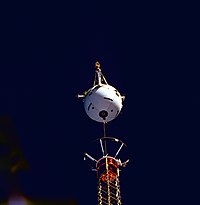
Photo from wikipedia
Cylindrical Langmuir probe measurements in a low-pressure DC argon discharge are used to obtain the spatial evolution of ion, cold and hot electron parameters across the cathodic pre-sheath. The cathodic… Click to show full abstract
Cylindrical Langmuir probe measurements in a low-pressure DC argon discharge are used to obtain the spatial evolution of ion, cold and hot electron parameters across the cathodic pre-sheath. The cathodic pre-sheath is formed by a stainless steel plate allowed to float negatively with respect to the plasma. The velocity distribution function of the hot electron population in the pre-sheath is shown to be matched by a drifting Maxwellian that thermalizes across it. The source of the hot electron population is hypothesized to arise from secondary electron emission from the plate. A Bayesian estimation routine is proposed to compare and validate different Langmuir probe models as well as calculating the relative uncertainty between models. The results are analyzed using existing pre-sheath theory for which experimental evidence of the spatial influence of energetic electrons is lacking. The data are shown to follow Riemann's pre-sheath model that the ion-neutral mean free path [Formula: see text] is proportional to the pre-sheath characteristic length l, and that the potential drop [Formula: see text] with distance x from the sheath/pre-sheath boundary x0 follows [Formula: see text].
Journal Title: Physics of Plasmas
Year Published: 2023
Link to full text (if available)
Share on Social Media: Sign Up to like & get
recommendations!